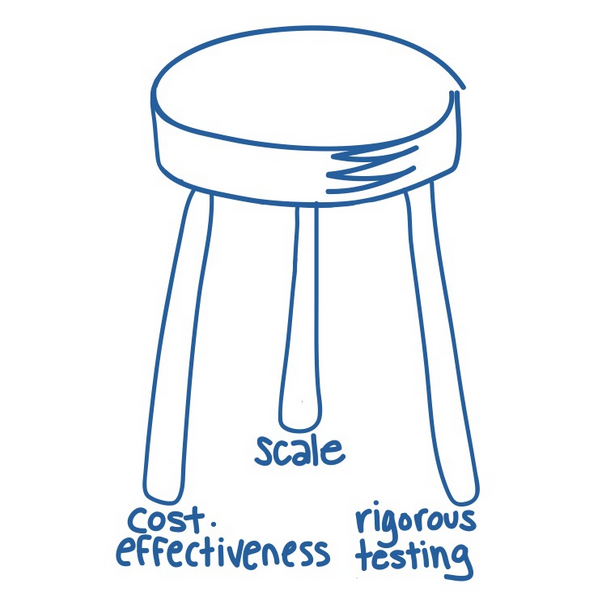- What We Do
- Agriculture and Food Security
- Democracy, Human Rights and Governance
- Economic Growth and Trade
- Education
- Ending Extreme Poverty
- Environment and Global Climate Change
- Gender Equality and Women's Empowerment
- Global Health
- Water and Sanitation
- Working in Crises and Conflict
- U.S. Global Development Lab
The DIV model is designed to find breakthrough solutions, minimize risk and maximize impact through staged financing, rigorously test impacts and cost effectiveness, and scale proven solutions through the public or private sectors. Through this model, DIV seeks to advance innovations that work while avoiding long term investments in those that don’t.
Breakthrough Solutions
DIV runs a year-round competition for bold development ideas and recognizes that breakthroughs can come from anywhere—a lab in a university, a local organization with deep contextual knowledge, or a passionate entrepreneur. Nearly any organization in the world is eligible to apply, and their proposals can be for any sector and any country in which USAID operates. Selection of winning applications is based on:

- Cost Effectiveness - DIV seeks applications that have the potential to deliver greater development impacts per dollar than standard practice.
- Rigorous Testing - The DIV model emphasizes testing potential solutions and rigorously evaluating impact to identify what works and what does not, and to help scale only proven solutions.
- Pathways to Scale - Innovations are expected to eventually scale up through the public sector, the private sector, or in some cases a combination of the two. Public sector scaling plans demonstrate that grantees are likely to compel host country governments, multilateral donors or other public sector players to scale the innovation. Grantees who expect to scale through the private sector will plan to achieve commercial viability themselves, or convincingly demonstrate that other businesses will scale their innovation, or a combination of both.
Staged Financing
Drawing inspiration from product development enterprises, DIV uses a three-tiered staged finance model to maximize cost-effectiveness and minimize the risk of testing new ideas. Applicants can apply at any stage (staging is based on the content of the project, not the level of funding needed).
- Stage 1: Proof of Concept/Initial Testing
Stage 1 grants support the introduction of a solution in a developing country context to gain an early, real-world assessment of the solution. This includes testing for technical, organization, distribution, and financial viability. Key activities could include assessing user demand, willingness to pay, and correct usage of products and services, as well as documenting social outcomes and real world costs to implement the solution. Stage 1 funding levels range from $25,000 to $150,000 per project and can aupport activities for up to three years.
- Stage 2: Testing and Positioning for Scale
Stage 2 grants support testing for social impact, improved outcomes and/or market viability, as well as operational refinement to build paths to sustainability and scale. Stage 2 applicants should have already met all the requirements of a Stage 1 project described above. Stage 2 projects range from $150,000 to $1,500,000 and can include activities for up to three years.
- Stage 3: Transitioning Proven Solutions to Scale
Stage 3 grants support transitioning proven approaches to scale, which could include adaptation to new contexts and geographies. Operational challenges for scaling should be identified and addressed, allowing refinement and iteration along defined pathways to scale. Stage 3 applicants must explain how they will use DIV funds in a catalytic fashion so that they can raise needed resources from sources other than DIV. Stage 3 funding and support provide a runway for applicants to grow, while engaging additional partners who will help scale the project beyond DIV support, but for whom more evidence of success and track record are needed. Stage 3 projects range from $1,500,000 to $15,000,000 and can include activities for up to five years.
More information on each stage can be found on DIV's "What We Look For" page.
Rigorous Testing of Impact and Cost Effectiveness
DIV is designed to help find, test and transition to scale the most effective innovations, and encourages the use of rigorous testing methods (e.g. market tests, or measuring causal impacts) as appropriate given the stage of the proposal and the scale path. Evidence can encompass ultimate impacts (e.g., infant mortality) or improvements in implementation outcomes (e.g. take-up) for those solutions that have been causally linked to ultimate impacts in the past. DIV seeks innovations that deliver more development impacts per dollar than other ways of achieving the same development goals (e.g. increased literacy per dollar compared to existing practices).
Criteria for collecting/demonstrating evidence of impact and cost-effectiveness vary by stage. See DIV's "What We Look For" page for additional details.
Pathways to Scale
The ultimate goal of DIV is to support solutions to scale sustainably to reach millions of people in the developing world within a decade. DIV recognizes that innovations can take a variety of scale paths but expects that ultimately they will grow without continued DIV support.
For more information on DIV expectations regarding scaling considerations at each stage, see DIV's "What We Look For" page.







Comment
Make a general inquiry or suggest an improvement.